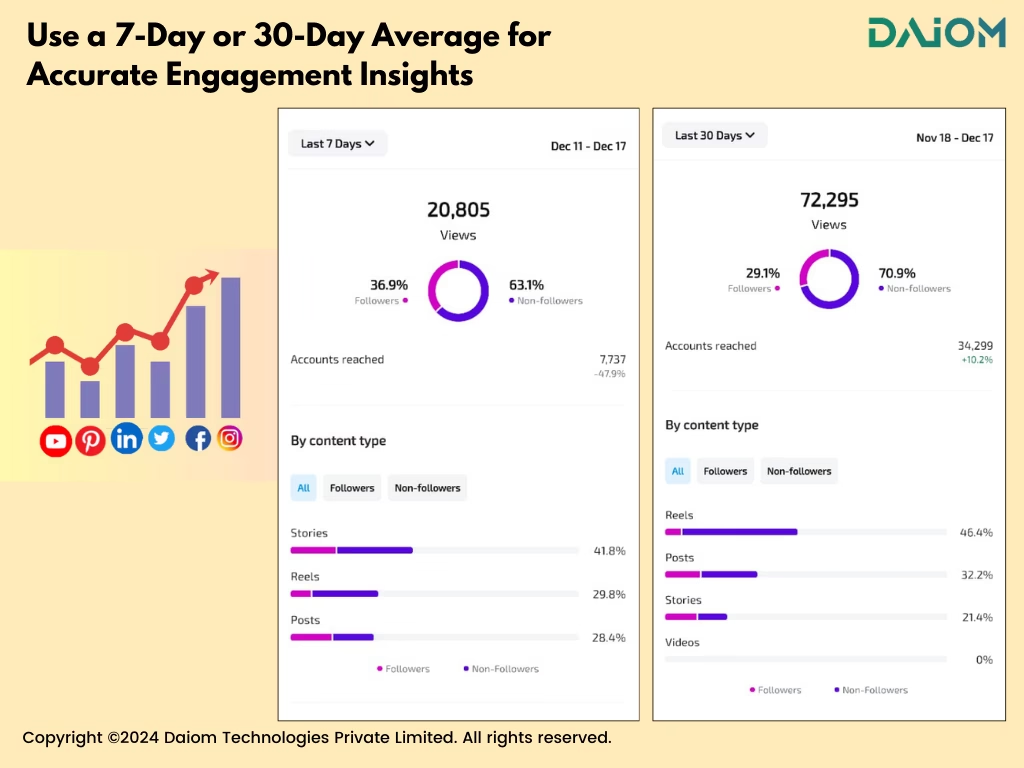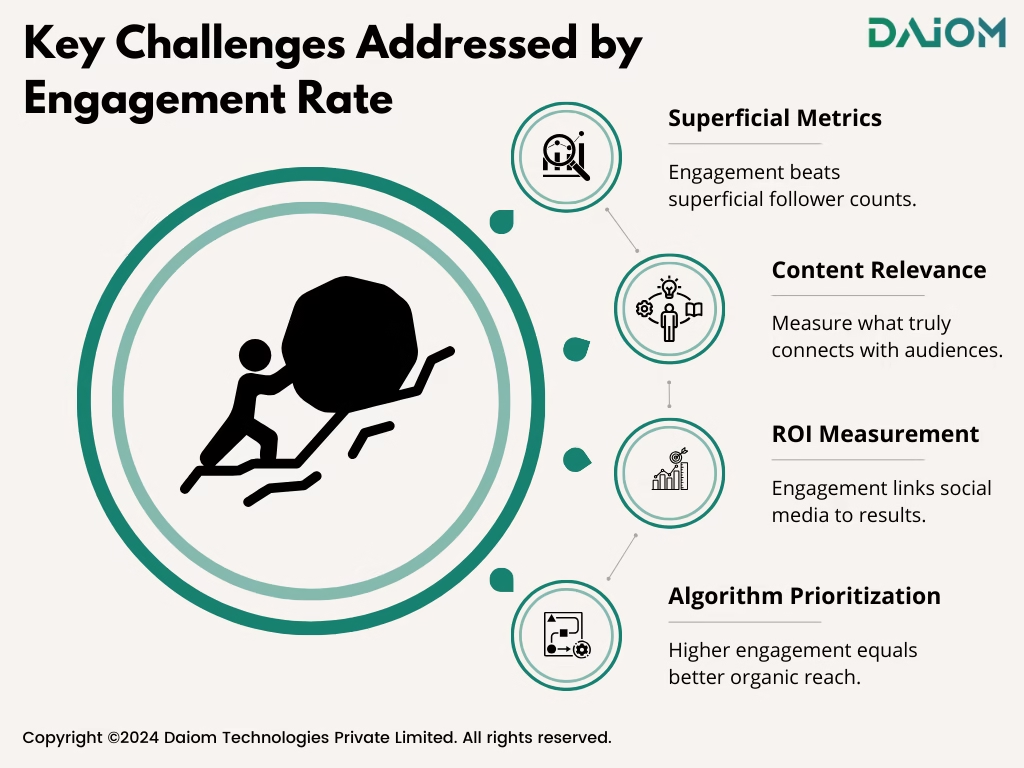People spend a lot of money on organic social media but measuring organic social media success is not clear. Metrics like followers or likes are often treated as indicators of success, but they can be misleading.
Followers can be bought, and likes alone don’t capture audience depth. That’s where Engagement Rate steps in—a critical KPI that measures how actively an audience interacts with content, reflecting genuine interest and connection.
So, what defines a “good” engagement rate?
Through a study of 100 brands, we found that average engagement rates vary widely across industries. For instance:
- The food industry typically sees rates between 1-3%.
- Lifestyle brands often operate within a similar range.
- Individuals, on the other hand, generally achieve much higher engagement rates compared to brands due to personal connections and authenticity.
To truly measure engagement, a single post isn’t enough. Brands should analyze a 7-day or 30-day average for a more accurate picture.

Poor engagement rates often result from inactive followers, low-quality content, or excessive boosting that attracts the wrong audience.
This blog explores how brands can use Engagement Rate as a meaningful metric to:
- Benchmark performance
- Identify areas for improvement
- Allocate resources effectively
By understanding and optimizing this KPI, brands can transform their social media strategies into impactful, result-driven initiatives.
Table of Contents
- What Is Engagement Rate And Why It Matters for Social Media Success?
- Key Factors Influencing Engagement Rate Across Platforms and Industries
- How To Calculate Engagement Rate?
- Key Challenges Addressed by Engagement Rate
- How Does Social Media Engagement Rate Impact Decision Making?
- Common Mistakes Brands Make While Monitoring Engagement Rate
- How to Boost Engagement Rate?
- Conclusion
1. What Is Engagement Rate And Why It Matters for Social Media Success?
Engagement rate represents the percentage of your audience who actively interact with your content at the time of posting, either by liking, commenting, or engaging in another form of interaction. It reflects the level of engagement your content generates among those who have seen it.

Without a clear metric like Engagement Rate, it’s difficult to know if the content or ads are truly impactful.
Even after spending time and resources on content creation and advertising, understanding whether these efforts are moving the brand in the right direction requires a KPI.
- Engagement Rate helps track the effectiveness of these strategies, ensuring resources are allocated wisely.
- By monitoring this KPI, brands can assess whether their audience is genuinely interested in the content, allowing them to refine strategies for better results.

2. Key Factors Influencing Engagement Rate Across Platforms and Industries
Tracking Engagement Rate without comparing it to industry benchmarks can be misleading. Benchmarks help brands understand if their social media efforts are on track.

The three biggest factors that determine a high engagement rate are:
- Platform: Engagement rates can vary significantly across platforms and may change over time. For example, TikTok typically has a higher engagement rate than Instagram at the moment.
- Industry: Engagement rates also differ by industry. Fashion and entertainment tend to see higher engagement than sectors like finance, except on LinkedIn. When assessing your engagement rate, it’s important to compare it with other brands in your industry.
- Follower Count: Generally, as your follower count increases, your engagement rate tends to decrease. Smaller accounts usually have a more engaged and passionate audience, resulting in a higher engagement rate.
3. How To Calculate Engagement Rate?
Engagement rate for any social media channel is calculated as a percentage that measures how actively the audience interacts with a brand’s content in relation to the brand’s total followers.
This metric helps understand not only the size of the audience but also the depth of their connection with the brand.
The formula for calculating engagement rate is:

Engagement Rate = (Total Engagements / Total Followers) x 100
Total engagement includes:

- Likes, reactions, and favorites
- Comments and replies
- Shares, retweets, and reposts
- Clicks on links, profiles, or media
- Saves (on platforms like Instagram or Pinterest)
This metric gives brands insights into how effectively their content resonates with the audience and drives meaningful interactions, helping to refine social media strategies and achieve business goals.
Read more – Driving Business Impact through Social Media Marketing
4. Key Challenges Addressed by Engagement Rate
Social media metrics often fail to capture the full picture of audience engagement. The engagement rate helps to go beyond surface-level metrics and provides deeper insights into how content is truly connecting with users. Here are the key challenges it addresses:

- Superficial Metrics: Views and follower counts show visibility, but don’t reflect genuine audience engagement. Engagement rate, focusing on likes, comments, and shares, reveals true interest.
- Content Relevance: Engagement rate shows what content resonates with the audience, helping brands refine strategies and create more of what people value.
- ROI Measurement: Engagement rate links social media efforts to real business outcomes, like brand awareness, customer loyalty, and sales.
- Algorithm Prioritization: High engagement boosts content visibility on social media platforms, enhancing organic reach without relying solely on paid ads.
5. How Does Social Media Engagement Rate Impact Decision Making?
The Engagement Rate KPI helps brands assess the performance of their social media strategy across platforms like LinkedIn, Facebook, or Instagram.
When engagement is high, it’s often a sign that users are more likely to click on links, make purchases, or follow through on calls to action. This can lead to higher conversions and a better return on investment (ROI).
However, if engagement is high but conversions are low, it may indicate that the content, although engaging, is not guiding users effectively through the sales funnel or attracting the wrong audience.
This KPI is valuable in making key business decisions, such as:

- Evaluating Content Performance: By comparing engagement rates across different types of content (e.g., Instagram Stories versus static posts), brands can optimize future strategies to focus on what works best.
- Gaining Audience Insights: Understanding which content resonates most, such as educational posts getting more likes and shares, helps brands create more of what their audience values.
- Measuring Campaign Effectiveness: Tracking engagement during specific campaigns helps assess how well they are engaging the audience. For example, a high engagement rate during a product launch indicates strong interest.
- Assessing Influencer Effectiveness: Engagement rate is essential for evaluating influencers. An influencer with a higher engagement rate may deliver better results than one with more followers but lower engagement.
- Optimizing Budget Allocation: High engagement on platforms like LinkedIn, compared to Twitter, may prompt brands to adjust their ad spend to focus more on the platform driving better results.
6. Common Mistakes Brands Make While Monitoring Engagement Rate
Brands can make several mistakes when tracking engagement rates on social media:
- Only Counting Likes and Reactions: Some brands count only likes or reactions as “engagement.” But real engagement also includes comments, shares, and saves, which give a better idea of how people feel about the content.
- Using the Same Benchmarks Across Platforms: Comparing engagement across different platforms, like Instagram and Twitter, can be confusing. Each platform is different, and engagement should be measured based on what works best for each one.
- Looking at Engagement Rate Alone: Brands sometimes look at engagement rate without considering what competitors are doing. It’s hard to know if the engagement is good unless you compare it to others in the same industry.
- Mixing Paid and Organic Engagement: Combining paid ads and organic (unpaid) engagement can give a false picture. Paid ads often get more engagement, so it’s important to track them separately to see how the organic content is truly performing.
- Not Tracking Engagement Trends: It’s important to look at how engagement changes over time. This helps see patterns like seasonal changes or which types of content people respond to, making it easier to adjust strategies as needed.
7. How to Boost Engagement Rate?
Boosting engagement rate is about doing the right things consistently. Here are some practical tips:

- Focus on Quality Content: Platforms like Instagram and TikTok reward unique, visually appealing content. For example, short-form videos often see 50% higher engagement than static images.
- Know Your Audience: Use tools like Facebook Insights or Google Analytics to understand your audience’s preferences. This helps create targeted campaigns that connect with people, leading to better results.
- Leverage Timing and Trends: Timing matters. Posts made during peak times, like weekends or evenings, generally see more engagement, especially for lifestyle brands.
- Experiment with CTAs: A simple call-to-action (CTA) can encourage followers to engage, whether it’s commenting on a post or signing up for a newsletter.
- Monitor and Adjust: Social media moves quickly. By checking your KPIs regularly and making tweaks, strategies can stay fresh and effective.
Engagement is not about how many people you reach, it's about how many people you affect.
Jay Baer, Digital Marketing Consultant & Author.
8. Conclusion
Engagement rates are like a map that show brands how well their posts are connecting with people and whether a brand is moving toward its goals.
It tells if people are interested in what’s shared, not just looking at it.
So, the next time you check the numbers, ask: Are the efforts truly connecting with people, or just being seen?
If you’d like to discuss how we can help enhance and optimize your social media, we’d be happy to set up a consultation call. Feel free to reach out to us at alibha@daiom.in
For more informative content and blog, follow and stay tuned to DAiOM.
Subscribe to our NEWSLETTER!


